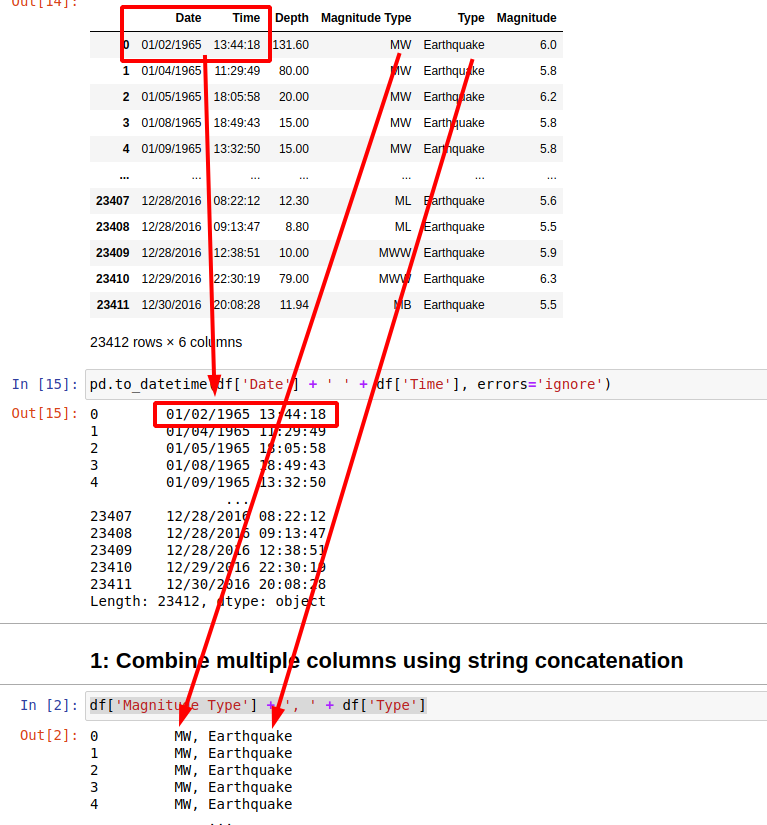In this short guide, you'll see how to combine multiple columns into a single one in Pandas.
Here you can find the short answer:
(1) String concatenation
df['Magnitude Type'] + ', ' + df['Type']
(2) Using methods agg and join
df[['Date', 'Time']].T.agg(','.join)
(3) Using lambda and join
df[['Date', 'Time']].agg(lambda x: ','.join(x.values), axis=1).T
So let's see several useful examples on how to combine several columns into one with Pandas.
Suppose you have data like:
| Date | Time | Depth | Magnitude Type | Type | Magnitude |
|---|---|---|---|---|---|
| 01/02/1965 | 13:44:18 | 131.6 | MW | Earthquake | 6.0 |
| 01/04/1965 | 11:29:49 | 80.0 | MW | Earthquake | 5.8 |
| 01/05/1965 | 18:05:58 | 20.0 | MW | Earthquake | 6.2 |
| 01/08/1965 | 18:49:43 | 15.0 | MW | Earthquake | 5.8 |
| 01/09/1965 | 13:32:50 | 15.0 | MW | Earthquake | 5.8 |
1: Combine multiple columns using string concatenation
Let's start with most simple example - to combine two string columns into a single one separated by a comma:
df['Magnitude Type'] + ', ' + df['Type']
result will be:
0 MW, Earthquake
1 MW, Earthquake
2 MW, Earthquake
3 MW, Earthquake
4 MW, Earthquake
What if one of the columns is not a string? Then you will get error like:
TypeError: can only concatenate str (not "float") to str
To avoid this error you can convert the column by using method .astype(str):
df['Magnitude Type'] + ', ' + df['Magnitude'].astype(str)
result:
0 MW, 6.0
1 MW, 5.8
2 MW, 6.2
3 MW, 5.8
4 MW, 5.8
2: Combine date and time columns into DateTime column
What if you have separate columns for the date and the time. You can concatenate them into a single one by using string concatenation and conversion to datetime:
pd.to_datetime(df['Date'] + ' ' + df['Time'], errors='ignore')
In case of missing or incorrect data we will need to add parameter: errors='ignore' in order to avoid error:
ParserError: Unknown string format: 1975-02-23T02:58:41.000Z 1975-02-23T02:58:41.000Z

3: Combine multiple columns with agg and join
Another option to concatenate multiple columns is by using two Pandas methods:
aggjoin
df[['Date', 'Time']].T.agg(','.join)
result:
0 01/02/1965,13:44:18
1 01/04/1965,11:29:49
2 01/05/1965,18:05:58
3 01/08/1965,18:49:43
This one might be a bit slower than the first one.
4: Combine multiple columns with lambda and join
You can use lambda expressions in order to concatenate multiple columns. The advantages of this method are several:
- you can have condition on your input - like filter
- output can be customised
- better control on dtypes
To combine columns date and time we can do:
df[['Date', 'Time']].agg(lambda x: ','.join(x.values), axis=1).T
In the next section you can find how we can use this option in order to combine columns with the same name.
5: Combine columns which have the same name
Finally let's combine all columns which have exactly the same name in a Pandas DataFrame.
First let's create duplicate columns by:
df.columns = ['Date', 'Date', 'Depth', 'Magnitude Type', 'Type', 'Magnitude']
df
A general solution which concatenates columns with duplicate names can be:
df.groupby(df.columns, axis=1).agg(lambda x: x.apply(lambda y: ','.join([str(l) for l in y if str(l) != "nan"]), axis=1))
This will result into:
| Date | Depth | Magnitude | Magnitude Type | Type |
|---|---|---|---|---|
| 01/02/1965,13:44:18 | 131.6 | 6.0 | MW | Earthquake |
| 01/04/1965,11:29:49 | 80.0 | 5.8 | MW | Earthquake |
| 01/05/1965,18:05:58 | 20.0 | 6.2 | MW | Earthquake |
| 01/08/1965,18:49:43 | 15.0 | 5.8 | MW | Earthquake |
| 01/09/1965,13:32:50 | 15.0 | 5.8 | MW | Earthquake |
How does it work? First is grouping the columns which share the same name:
for i in df.groupby(df.columns, axis=1):
print(i)
result:
('Date', Date Date
0 01/02/1965 13:44:18
1 01/04/1965 11:29:49
2 01/05/1965 18:05:58
3 01/08/1965 18:49:43
4 01/09/1965 13:32:50
... ... ...
23407 12/28/2016 08:22:12
23408 12/28/2016 09:13:47
23409 12/28/2016 12:38:51
23410 12/29/2016 22:30:19
23411 12/30/2016 20:08:28
[23412 rows x 2 columns])
('Depth', Depth
0 131.60
1 80.00
2 20.00
3 15.00
4 15.00
... ...
23407 12.30
23408 8.80
Then it's combining their values:
df.groupby(df.columns, axis=1).apply(lambda x: x.values)
result:
Date [[01/02/1965, 13:44:18], [01/04/1965, 11:29:49...
Depth [[131.6], [80.0], [20.0], [15.0], [15.0], [35....
Magnitude [[6.0], [5.8], [6.2], [5.8], [5.8], [6.7], [5....
Magnitude Type [[MW], [MW], [MW], [MW], [MW], [MW], [MW], [MW...
Type [[Earthquake], [Earthquake], [Earthquake], [Ea...
Finally there is prevention of errors in case of bad values like NaN, missing values, None, different formats etc.









